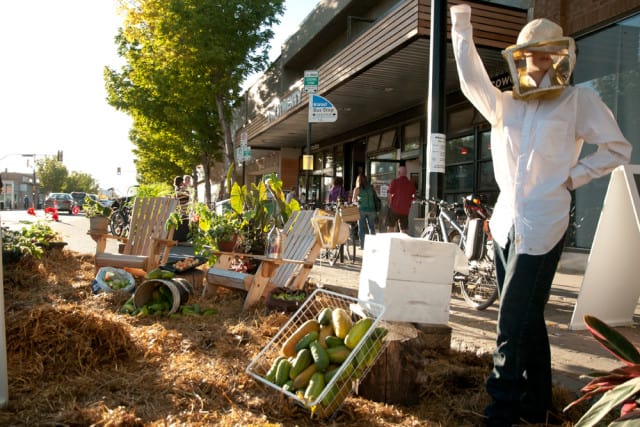NATHAN JONES

All kinds of parks, mini-events, and green spaces sprung up in parking stalls along Broadway and 20th street.
Pedestrians packed the Broadway Theatre Sept. 20 as 400-plus curious attendee’s waited patiently to kick off Saskatoon’s first Park(ing) Day.
The group flocked to the community-owned theatre in anticipation of an informative and entertaining presentation by globally-renowned urban planner and architect Ken Greenberg.
Greenberg was asked by the City of Saskatoon to help create a feasible long-term growth plan with local planners and to act as the keynote speaker for Park(ing) Day.
Park(ing) Day was launched in San Francisco in 2005 and encourages citizens to rethink parking spaces by transforming them into more enjoyable public spaces. Saskatoon’s inaugural event saw an entire lot on the corner of 20th Street West and Avenue B filled with sod, hay bales and food carts. It saw another stall occupied by an upside down car with numerous plants sprouting from the undercarriage and it saw one stall packed with a group of friends sprawled out on couches occasionally breaking into an impromptu jam session. And these were just a few of the many public spaces found on Park(ing) Day.
Greenberg has left his distinctive mark on major cities across the globe, including Detroit, Paris, Toronto, Chicago and Amsterdam.
Launching into a brief history of the urban sprawl epidemic, Greenberg took the audience back to before the Second World War, when cities were planned for pedestrian convenience.
Shortly after this, promises of an abundance of cheap energy and freedom sent families flocking to the suburbs, which would revolutionize the development of nearly every city in North America. Noting that Toronto’s average commute was 88 minutes, the highest in North America, Greenberg foreshadowed the daunting future for growing cities if urban sprawl is not brought to a halt.
This dominant North American pattern of development, marked by what Greenberg described as “forlorn arteries lined with parking lots,” has made us, for the most part, dependent on the automobile.
With average suburban families spending up to 40 per cent of their salaries on transportation and cities having to undertake mass infrastructure projects to support these habits, suburbia has created an economic black hole.
Greenberg advocated for the revitalization of downtown Saskatoon and for more green space in core areas of the city.
Describing public urban spaces as a “living space that belongs to everyone,” he suggested that we have to find and create breeding grounds for artistic, cultural and social activities.
Greenberg often referred to the multitude of parking lots that speckle many downtown areas as wasted space. He endorsed the renewal of these spaces as high density living spaces or public areas that offer opportunity for citizens to interact and be active.
Greenberg concluded his speech by making a encouraging revelation.
The sustainable city is not a lifestyle choice but an unavoidable reality. With ever-increasing population and energy prices the move to creating pedestrian-friendly cities, though imposing, is imperative for the future.
According to Greenberg, a city is a “living organism, capable of change,” and its citizens need to embrace and support the changes as it develops.
[box type=”info”]For more information on Saskatoon’s growth plan see igp.saskatooncitynews.ca.[/box]—
Photo: Raisa Pezderic/The Sheaf